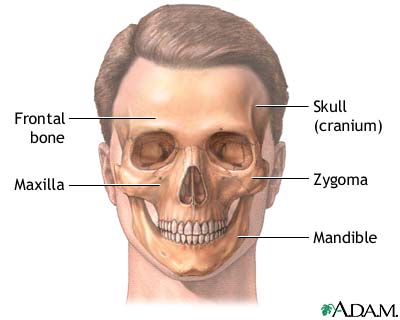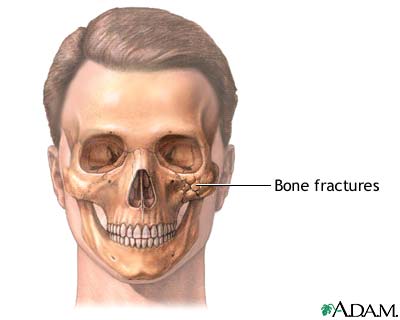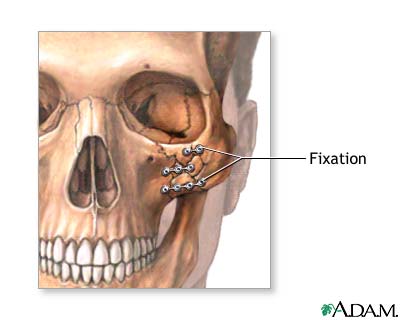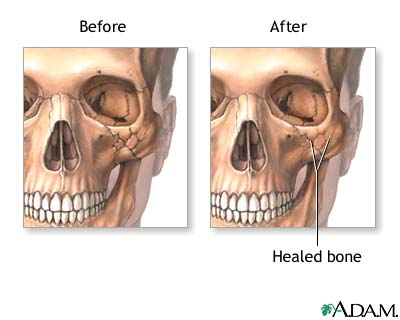Health Library
Craniofacial reconstruction - series

Normal anatomy
There are four major bones of the face the maxilla, the zygoma, the mandible, and the frontal bone of the cranium.

Indications
Patients requiring craniofacial reconstruction have:
- Birth defects (such as hypertelorism, Crouzon's disease, Apert's syndrome)
- Injuries to the head, face, or jaws (maxillofacial)
- Tumors
- Deformities caused by treatments of tumors

Procedure
While the patient is deep asleep and pain-free (under general anesthesia) some of the facial bones are cut and repositioned into a more normal facial structure. The procedure may take from four to 14 hours to complete. Pieces of bone (bone grafts) may be taken from the pelvis, ribs, or skull to fill in the spaces where bones of the face and head have been moved. Small metal screws and plates are sometimes be used to hold the bones in place and the jaw may be wired together to hold the new bone positions in place.
If the surgery is expected to cause significant swelling of the face, mouth, or neck, the patient's airway may be an area of major concern. The airway tube (endotracheal tube) normally used for long surgical procedures under general anesthesia may be replaced with an opening and tube directly into the airway (trachea) in the neck (tracheotomy).

Aftercare
Depending on the extent of surgery and how the patient is breathing, the first two days after surgery may be spent in the intensive care unit. Without complications, most patients are able to leave the hospital within one week. Complete healing may take up to six weeks.
BACK TO TOP
Review Date: 5/26/2023
Reviewed By: Tang Ho, MD, Associate Professor, Division of Facial Plastic and Reconstructive Surgery, Department of Otolaryngology - Head and Neck Surgery, The University of Texas Medical School at Houston, Houston, TX. Also reviewed by David C. Dugdale, MD, Medical Director, Brenda Conaway, Editorial Director, and the A.D.A.M. Editorial team.
 | A.D.A.M., Inc. is accredited by URAC, for Health Content Provider (www.urac.org). URAC's accreditation program is an independent audit to verify that A.D.A.M. follows rigorous standards of quality and accountability. A.D.A.M. is among the first to achieve this important distinction for online health information and services. Learn more about A.D.A.M.'s editorial policy, editorial process and privacy policy. A.D.A.M. is also a founding member of Hi-Ethics. This site complies with the HONcode standard for trustworthy health information: verify here. |
The information provided herein should not be used during any medical emergency or for the diagnosis or treatment of any medical condition. A licensed medical professional should be consulted for diagnosis and treatment of any and all medical conditions. Links to other sites are provided for information only -- they do not constitute endorsements of those other sites. No warranty of any kind, either expressed or implied, is made as to the accuracy, reliability, timeliness, or correctness of any translations made by a third-party service of the information provided herein into any other language. © 1997- 2024 A.D.A.M., a business unit of Ebix, Inc. Any duplication or distribution of the information contained herein is strictly prohibited.
